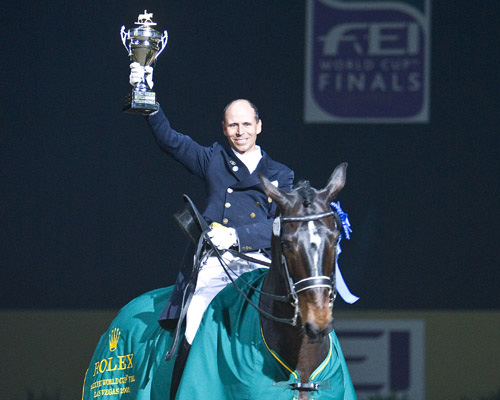Two-Tier World Cup Treatment–Europe & Rest of the World
13 years ago StraightArrow Comments Off on Two-Tier World Cup Treatment–Europe & Rest of the World

By KENNETH J. BRADDICK
The last World Cup dressage Final qualifying competitions for 2012 are underway on both coasts of the United States this weekend but for the two North Americans who win a ticket to the only annual global championship it is not the end of quest. Before they and their horses can get on a plane to go to Europe, they have to come up with a large chunk of cash to cover the bills.
The last World Cup events of the 2011/2012 season are being held at Del Mar, California, and West Palm Beach, Florida, leading to the Final in ‘s-Hertogenbosch, The Netherlands, April 18-22.
For the two places reserved for the U.S. and Canada, riders receive $12,000 (€9,000) toward the round trip transportation for their horse and $1,650 (€1,245) for travel by the rider. For the sole combination from the Pacific League, an Australian in 2012 as in most years, the amounts are $16,500 (€12,400) for the horse and $2,200 (€1,669) for the athlete.
The nine or 10 Europeans who competed in Las Vegas at each of the three Finals in the past eight years had all their costs picked up by the organizers under the contract with the International Equestrian Federation (FEI) that owns the event and makes the rules.
In the case of North America, transportation companies estimate the organizer contribution at about half the out-of-pocket costs.
Further underscoring a widespread belief that the World Cup is a European show created for the indoor circuit that is not the norm elsewhere, is that the Western European League is the only one of four geographic leagues that is sponsored as a series. The nine events in the WEL were also televised live on the Internet under the auspices of the FEI which also distributed news and photo reports of each event to media around the globe.
The Central European, North American and Pacific Leagues received none of the event-by-event television and news coverage. Sponsorship came from efforts by individual show organizers for their own events.
The FEI explains the two-tiered system this way in response to questions from dressage-news.com: “The agreement that organizers of Finals staged outside Europe will cover transportation costs for horses and riders traveling from Europe is accepted by the Organizing Committees as the best way to secure the highest number of top athletes possible, which not only benefits the Event itself, but also its sponsors, the media and spectators.”
Anne Gribbons, the U.S. dressage coach and the only non-European on the six-member FEI Dressage Committee, sees it differently.
“I have expressed the view several times to the Dressage Committee that when horses and riders come from outside Europe to a European Final they have a long flight to deal with and the money paid to them does not cover half their expenses. The Europeans were fully paid for in Las Vegas. It has never happened to us.
“It is not easy for someone who has gone through the process of qualifying and then does not have the same generous full sponsorship as the Europeans.”
U.S. rider Debbie McDonald won the World Cup Final in 2003 and Steffen Peters in 2009.
An example of the impact of the different levels of financial support is James Koford, a highly popular U.S. rider with no sponsorship and who makes his living training horses and teaching riders. He may take a horse borrowed from one of his students if he is one of the two Americans in the 2012 Final.
He won or placed high to take the lion’s share of substantial prize money offered at the newly created Global Dressage Festival’s two World Cup events in Wellington, Florida.
“If I qualify I will owe the fact that I can afford to go to the Global Dressage Festival,” he told dressage-news.com.
Since the first dressage World Cup in 1986, the Final has been held four times in the United States three times in the past eight years, in Las Vegas in 2005, 2007 and 2007. The city is expected to be awarded it again in 2015.
Dressage drew more spectators than the jumping Final that was held at the same time at the three Las Vegas events.
But when the event is not held in the U.S. interest has frequently been low in North America. Two years ago, no U.S. or Canadian combination competed for the first time ever.
And this year, the U.S. Equestrian Federation committee that sets the agenda for high performance dressage also dealt a serious blow to the World Cup and freestyles in general when it decided that only scores from the Grand Prix and the Olympic Grand Prix Special would count toward selection for the team for the London Olympics.
American competition organizers had won commitments for the highest financial sponsorship in the history of freestyles in North America with complementary marketing campaigns, only to face the bleak prospect of as few as two or three combinations in the freestyle.
The World Cup was created as the only annual global championship as a winter indoor series and to promote dressage by making the musical freestyle its centerpiece. The Netherlands’ Anky van Grunsven has been the supreme performer winning it nine times out of the 11 occasions her country has claimed the title. German combinations have won it seven times.

